MARPE Miniscrew Assisted Rapid Palatal Expander | MSE manufacturer

This page is intended for orthdontic specialists looking to buy the MARPE / MSE expansion excrew with usefull clinical information.
Are you dealing with overcrowding, crossbite, or narrow arches?
MARPE (Mini-Implant Assisted Rapid Palatal Expander) is an excellent solution for young adults without the need to do SARPE or orthognathic surgery. With the use of mini-implants, the force of expansion is transmitted to the palatal bone allowing the midpalatal suture to open easily. MARPE is a non-invasive surgical procedure that is gaining popularity for its effectiveness in treating these issues and getting rapid palatal expansion.

Introduction
When it comes to orthodontic treatment, the Mini-screw Assisted Rapid Palatal Expander (MARPE) or Surgical Maxillary Expander (SME) has emerged as a popular alternative to traditional Rapid Palatal Expanders for certain patients to get rapid maxillary expansion. It is designed to widen the upper jaw and nasal cavity in a short period of time. MARPE involves placing mini implants in the palate and using a special key to activate the expander. This technique is often used to address issues such as crowding, crossbite, mouth breathing and some cases of obstructive sleep apnea (OSA).
MARPE Indications
Before using a MARPE, a comprehensive diagnosis is very important to determine eligibility for the procedure. Age and gender are the two most important factors to be considered for a successful treatment1with 94% success in female patients (mean age 19 years; age range 6-60 years) compared to 61% success in male patients (mean age 20 years; age range 6-60 years) . If qualified, it might be used to treat a variety of dental and skeletal problems such as:
- Severe narrow maxilla, which is diagnosed by a transverse maxillary deficiency,
- Bilateral posterior cross bite,
- Unilateral posterior cross bite,
- CL III skeletal problems with midfacial deficiency where a face mask is recommended to facilitate facial development (Ref).
- and more !
What is MARPE?
MARPE is a modified traditional Rapid Palatal Expander RPE with additional holes to accommodate the usage of mini-implants. This will allow the expansion force to be transmitted directly to the palatal / maxillary bone through the mini implants. The expander works by turning the screw 1/4 turn " 0.2 mm " which will gradually apply pressure to the mid-palatal suture. Over time, this pressure causes the suture to separate, creating more space in the mouth and nose with a better skeletal effect.
MARPE provides a viable alternative to traditional palatal expanders and can achieve greater maxillary expansion within a shorter time frame. The MARPE screw could be left in the patient’s mouth while moving the teeth independently. This retention phase is important to build new bone and minimize relapse for a future stable bite.
It is important to understand that during maxillary expansion, the main resistance forces occur at the zygomatico-maxillary sutures, and not in the median palatal suture. (REF)
MARPE manufacturer and Screw Types
There are few companies that manufacture the MARPE screw under different brand names:
- BMK Seoul - Korea, the name of the screw is MSE and it is sold in the USA by Great Lakes orthodontics
- IOS USA, the name of the screw in Infinity Skeletal Expander
- Dentaurum Germany, the name of their system in Thomas Palatal Expansion.
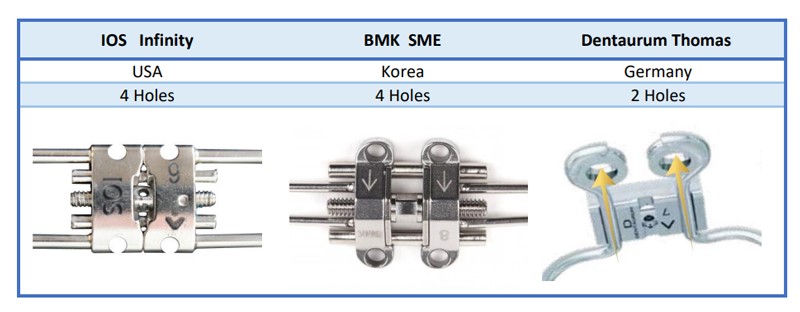
We recommend the use of IOS infinity Long mini-Implant 1.5mm on children and young teenagers and Long mini-implants 1.8 mm for older patients. This is important to minimize the risk of breaking the mini-screw during the procedure as the bone is denser in older patients.
Advantages of using IOS Infinity Surgical Expander
Unlike other brands, IOS has pioneered the concept of implementing a surface guide in each hole to facilitate the mini implant insertion in a 90 degree angle so all 4 screws are parallel to each other with a tight fit against the walls of the holes. This tightness will minimize the bending possibility of the mini implants while being loaded during expansion.
The holes are also inside the body of the expander, this has two benefits:
- The body of the expander is smaller, and
- The mini implants are closer to the screw of the skeletal expander.
As you notice in the picture, these holes are not complete. Each hole is specially engineered with only 3/4 of a circle. The incomplete hole will allow to remove the MARPE easier in emergency cases.
The hole with the guided surface is 1.85 mm in width, such accepting both 1.8 mm and 1.5 mm MARPE expander screw.
The IOS Infinity Surgical Expander comes as 7 mm and 9 mm.
How does the MARPE expander screw work?
There are two major ways to use the MARPE:
- Bone-Borne MARPE: The expander will be attached to the bone with 4 mini implants directly without teeth involvement to achieve pure skeletal expansion.
- Hybrid Bone/Teeth Borne MARPE: The expander will have attachments to the bone as well as the first molars using molar bands. The bands will transfer the force to the basal bone of the maxilla.
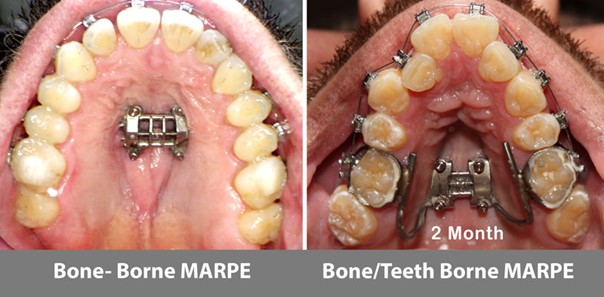
Research and systematic review2 3 have shown that both expanders produced basal bone expansion at the level of the hard palate. The Bone/Teeth borne MARPE produced more dental expansion, buccal rolling, and a greater increase in nasal width than did the first one. On the other hand, the Bone-Borne expander has greater bone expansion by 0.8 mm. Lin et al has found that "For patients in late adolescence, bone-borne expanders produced greater orthopedic effects and fewer dentoalveolar side effects compared to the traditional hyrax expanders."
The MARPE expander screw is a key component of the MARPE. This screw is designed either with a hole ( IOS Infinity ) or with a hexagonal wrench ( BMK MSE ) with each turn expanding the screw 0.2 mm.
How to place a MARPE?
The MARPE has to be fabricated by a dental lab or by the orthodontist based on a dental impression or a digital scan. We will talk in this article about the Bone / Teeth borne MARPE. The procedure itself is relatively simple and can be completed with minimal invasiveness.
- make sure you have enough space mesial and distal to the upper first molars. We recommend the use of large separators like the purple cyber sepo ( IOS SKU 15-611-101)
- Try to fit the MARPE in the patient mouth. If adjustment is needed, use a heavy bird beak plier ( IOS SKU 18-205) or a Head gear plier ( IOS SKU 18-350 ) to make necessary adjustment.
- Sanitize the hard and soft palate with Peridex mouthwash and then apply topical gel where the future screws will go.
- Using a fine needle ( gauge 26 or smaller ) , apply local anesthesia till the area get white blanched. Insert the needle in a tilted direction, not perpendicular, to minimize patient's discomfort.
- Place the MARPE appliance in the patient mouth and do NOT cement the bands. We will cement the band after All screws are in.
- Using a dental motor or a hand tool ( IOS 20-210) , start inserting the first mini implant in one of the anterior holes, do not tighten the implant all the way down. This first mini implant will be tighten lastly.
- Place now the second mini implant in a posterior hole in the opposite direction. This will help to balance the MARPE in place and prevent any tilt in the appliance.
- Now place the third screw in the empty anterior hole and then place the forth one in the back. Now you can tighten the first one all the way in.
- Do not exceed more than 10 RPM if using the dental motor and make sure your hand is sturdy so the implant will not break.
- If you feel a lot of resistant, like when drilling into a tori, place the implant half away and then wait few minutes. This will allow the bone to expand and the insertion would be easier.
- Once all the screws are tightened, apply a glass-Ionomer cement ( Like Pink Rely-X from 3m) to cement the bands and seal the edges so food will not accumulate between the band and the tooth.
- Activate the MARPE by turning the screw 2x times and instruct the patient to turn once daily for 28 days.
- Patient is adviced to use a counter painkiller for the first few days.
TIP: Always leave 2 mm of space between the arms of the MARPE and the palate to minimize gingival impingement.
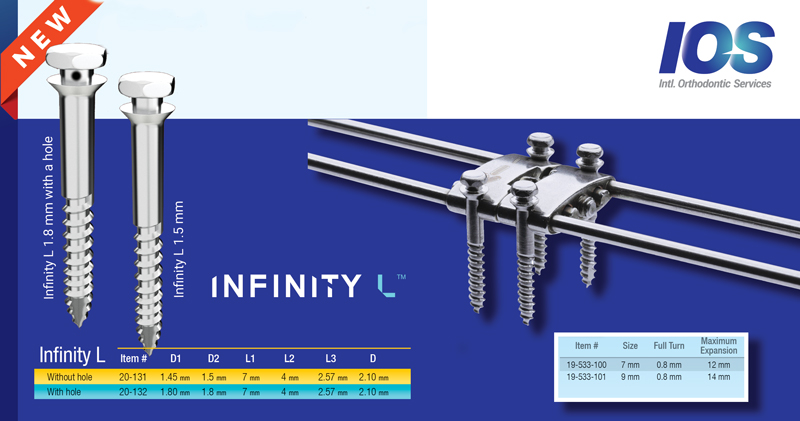
How long does the treatment take?
MARPE treatment time varies depending on the patient's age and the severity of the case. On average, it takes about 6-12 weeks to get enough midpalatal suture opening. This suture opening will be expressed in most cases as a gap between the front teeth. However, the absence of the gap is not always an indicator of a failure in suture opening. After 12 weeks, the MARPE expander screw is left at least for one year to get new bone. This is important to prevent any possible relapse.
It is very important to educate the patient not to turn the expander more than once a day. Research has shown that rapid expansion " Twice a day " resulted in more tipping of the molars and bending / failures of the mini screw when compared to slow expansion "every other day"
If the MARPE screw fails to open the suture, then SARPE surgical intervention is recommended to break the fused suture.
Case #1 with parallel suture opening.
Here is a patient with bilateral cross bite and short roots. The previous orthodontist discontinued the treatment to prevent any further root resorption. A MARPE expander screw / MSE was suggested to release the front teeth initially from the orthodontic forces while correcting the cross bite with the expander. The suture opened nicely and evenly 4.5 mm. No further root damage was detected on the front teeth and the cross bite was corrected. Total treatment time: 24 months
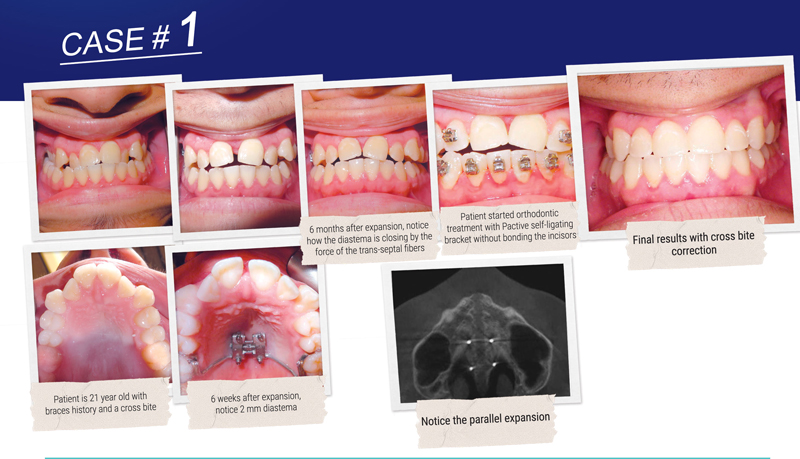
Case #2 for the airway
This patient has a breathing problem, with bilateral posterior cross bite and anterior open bite. A MARPE expander screw was recommended to correct the cross bite and enhance the breathing by minimizing the nasal resistance to airflow. The suture opened nicely in a parallel pattern.

Comparison between MARPE and other treatments
When it comes to correcting skeletal issues in the maxilla, the orthodontist have several options based on the age and severity of the case. While traditional palatal expanders and SARPE surgery are popular choices, MARPE offers an alternative that may be more effective for certain patients. Unlike other treatments, MARPE can also be used in some adults "especially females with a success rate up to 90%" without the need for surgery.
Efficacy of Miniscrew-Assisted Rapid Palatal Expander MARPE; Meta-Analysis
It is interesting to know how the MARPE is working to correct the transverse deficiency. Kapetanović et al studied a sample size of 34 patients (8 men, 26 women) with mean age 27 years. A success rate of 94.1% was achieved. They noted that the mean expansion at the maxillary first molars was 6.56 mm while the mean expansion at first premolars was 4.19mm.
The expansion for the first molar area was 60.4 ± 20.1% skeletal, 8.1 ± 27.6% alveolar process, and 31.6 ± 20.1% dental
The expansion for the first premolar was 92.2 ± 14.5% skeletal, 0.0 ± 18.6% alveolar process, and 7.8 ± 17.7% dental
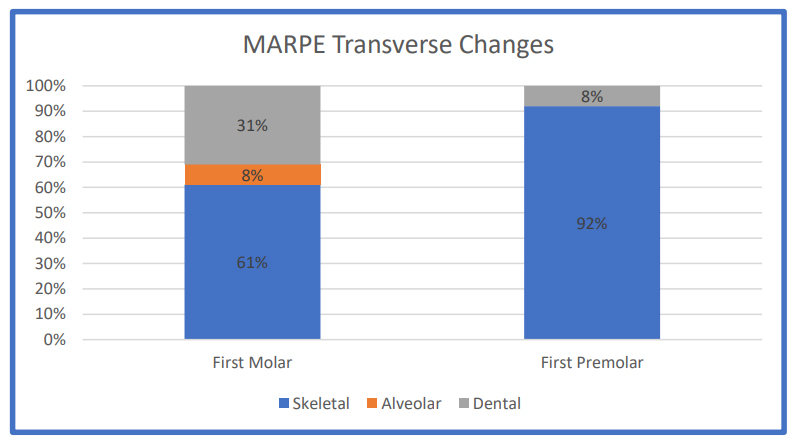
In another study, they found the followings expansion based on 14 articles:
- Skeletal expansion zygomatic width, 2.39 mm;
- Nasal width, 2.68 mm;
- jugular width, 3.12 mm;
- Midpalatal suture at the posterior nasal spine and anterior nasal spine, 3.34 mm and 4.56 mm, respectively;
- Alveolar molar width expansion, 4.80 mm;
- Dental expansion inter-canine width, 3.96 mm;
- Inter-premolar width, 4.99 mm; and
- Inter-molar width, 5.99 mm.
Risks and Limitations of MARPE
When considering the risks and limitations of MARPE, it is important to acknowledge that this non-surgical method of palate expansion may not be suitable for every patient. Factors such as age, bone density, and severity of dental issue can affect the success of the treatment. Additionally, patients may experience pain or discomfort during the procedure and there is a potential risk of damage to teeth or gums.
However, with proper consultation and follow-up care from an experienced orthodontist, many patients have successfully undergone MARPE treatment. It is crucial to take into account all the risks and limitations before deciding on this treatment option and communicate any concerns with your orthodontist.
Side effects of using MARPE
While MARPE is generally safe and effective, discomfort and pain are common during the expansion process. Patients may also experience difficulty speaking or eating for a short period of time.
- However, it is important to make the patient aware of other potential side effects such as:
- Gingival hypertrophy of the palatal mucosa associated with the MARPE device.
- Decrease in bone level and thickness at first molars in 40.7% of the cases.
- Asymmetric expansion
- A change in the occlusal plane that is observed as a cant in 10% of the cases.
- If the suture is fused, the mini-screws might bend or even get loose.
Follow-up appointments
It is normal to experience some discomfort or soreness during the first few days after the procedure, but this can be managed with over-the-counter pain relievers. Good oral hygiene practices are crucial during this time and beyond, so be sure to brush your teeth regularly and avoid hard or sticky foods that can damage the appliance. A water pick might be needed if it is hard for the patient to keep the area clean.
Conclusion
In conclusion, MARPE is a highly effective treatment for correcting maxillary deficiencies. It offers several advantages over traditional treatments like RPE and SARPE surgery, including minimal invasiveness, shorter treatment time, and reduced discomfort. However, it may not be suitable for everyone and can have some side effects.
References:
Jeon, J.Y., Choi, SH., Chung, C.J. et al. The success and effectiveness of miniscrew-assisted rapid palatal expansion are age- and sex-dependent. Clin Oral Invest 26, 2993–3003 (2022). https://doi.org/10.1007/s00784-021-04281-0
Lee KJ, Park YC, Park JY, Hwang WS. Miniscrew-assisted nonsurgical palatal expansion before orthognathic surgery for a patient with severe mandibular prognathism. Am J Orthod Dentofacial Orthop. 2010 Jun;137(6):830-9. doi: 10.1016/j.ajodo.2007.10.065. PMID: 20685540.
Mosleh MI, Kaddah MA, Abd ElSayed FA, ElSayed HS. Comparison of transverse changes during maxillary expansion with 4-point bone-borne and tooth-borne maxillary expanders. Am J Orthod Dentofacial Orthop. 2015 Oct;148(4):599-607. doi: 10.1016/j.ajodo.2015.04.040. PMID: 26432315.
Lin L, Ahn HW, Kim SJ, Moon SC, Kim SH, Nelson G. Tooth-borne vs bone-borne rapid maxillary expanders in late adolescence. Angle Orthod. 2015 Mar;85(2):253-62. doi: 10.2319/030514-156.1. Epub 2014 Dec 9. PMID: 25490552; PMCID: PMC8631879.
Lagravère MO, Carey J, Heo G, Toogood RW, Major PW. Transverse, vertical, and anteroposterior changes from bone-anchored maxillary expansion vs traditional rapid maxillary expansion: a randomized clinical trial. Am J Orthod Dentofacial Orthop. 2010 Mar;137(3):304.e1-12; discussion 304-5. doi: 10.1016/j.ajodo.2009.09.016. PMID: 20197161.
Yacout YM, Abdalla EM, El Harouny NM. Skeletal and dentoalveolar effects of slow vs rapid activation protocols of miniscrew-supported maxillary expanders in adolescents: A randomized clinical trial. Angle Orthod. 2022 Jun 30;92(5):579–88. doi: 10.2319/112121-856.1. Epub ahead of print. PMID: 35771652; PMCID: PMC9374350.
Kapetanović A, Odrosslij BMMJ, Baan F, Bergé SJ, Noverraz RRM, Schols JGJH, Xi T. Efficacy of Miniscrew-Assisted Rapid Palatal Expansion (MARPE) in late adolescents and adults with the Dutch Maxillary Expansion Device: a prospective clinical cohort study. Clin Oral Investig. 2022 Oct;26(10):6253-6263. doi: 10.1007/s00784-022-04577-9. Epub 2022 Jun 22. PMID: 35731323; PMCID: PMC9525423.
Kapetanović A, Theodorou CI, Bergé SJ, Schols JGJH, Xi T. Efficacy of Miniscrew-Assisted Rapid Palatal Expansion (MARPE) in late adolescents and adults: a systematic review and meta-analysis. Eur J Orthod. 2021 Jun 8;43(3):313-323. doi: 10.1093/ejo/cjab005. PMID: 33882127; PMCID: PMC8186837.
Siddhisaributr P, Khlongwanitchakul K, Anuwongnukroh N, Manopatanakul S, Viwattanatipa N. Effectiveness of miniscrew assisted rapid palatal expansion using cone beam computed tomography: A systematic review and metaanalysis. Korean J Orthod. https://doi.org/10.4041/kjod21.256
Bud ES, Bică CI, Păcurar M, Vaida P, Vlasa A, Martha K, Bud A. Observational Study Regarding Possible Side Effects of Miniscrew-Assisted Rapid Palatal Expander (MARPE) with or without the Use of Corticopuncture Therapy. Biology (Basel). 2021 Mar 3;10(3):187. doi: 10.3390/biology10030187. PMID: 33802266; PMCID: PMC8001817.
Sarraj M, Akyalcin S, He H, Xiang J, AlSaty G, Celenk-Koca T, et al. Comparison of skeletal and dentoalveolar changes between pure bone-borne and hybrid tooth-borne and bone-borne maxillary rapid palatal expanders using cone-beam computed tomography. APOS Trends Orthod 2021;11(1):32-40.

